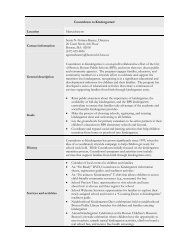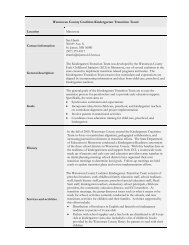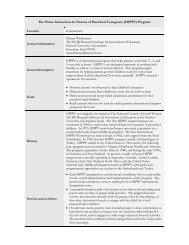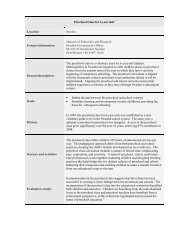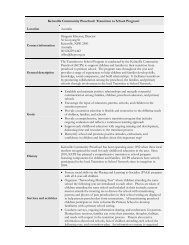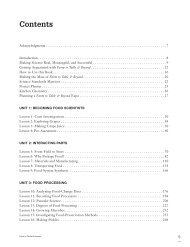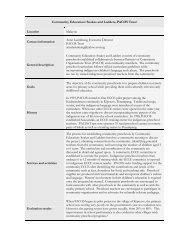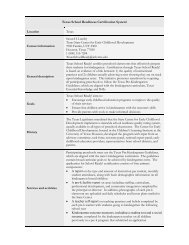Proceedings of the Fourth Annual Teachers College Educational ...
Proceedings of the Fourth Annual Teachers College Educational ...
Proceedings of the Fourth Annual Teachers College Educational ...
You also want an ePaper? Increase the reach of your titles
YUMPU automatically turns print PDFs into web optimized ePapers that Google loves.
Kidsteam members because <strong>the</strong>y have more CI design experience. The second group was composed <strong>of</strong><br />
seven children (three boys, four girls, ages 9–13) and adults that participated in <strong>the</strong> KC program. In 2011,<br />
KC was enacted as an all day, one-week summer program. At <strong>the</strong> end <strong>of</strong> KC, we asked <strong>the</strong> participants<br />
to engage in CI to develop new technologies for future versions KC. In comparison to Kidsteam, <strong>the</strong> KC<br />
designers did not have as much CI design experience. However, <strong>the</strong> KC participants had more<br />
experience completing <strong>the</strong> LRL activities.<br />
In <strong>the</strong>se sessions, we employed a low-tech prototyping technique called “Bags <strong>of</strong> Stuff” (Druin et al.,<br />
2001) (Figure 1). In this technique, <strong>the</strong> children and adults were split into different groups, with each<br />
group having one to two child partners and at least one adult. Each group was asked to create models <strong>of</strong><br />
new technologies using pre-determined art supplies found in large bags. During <strong>the</strong> design time, we took<br />
field notes, photos and recorded <strong>the</strong> session on video. Once <strong>the</strong>se models were created, <strong>the</strong> child-adult<br />
groups came toge<strong>the</strong>r again in a whole discussion group to present <strong>the</strong>ir designs. As <strong>the</strong> groups<br />
presented to <strong>the</strong> full team, we wrote on a large whiteboard “<strong>the</strong> big ideas” that were present, recording <strong>the</strong><br />
ideas that were <strong>the</strong> most repeated among <strong>the</strong> groups and received <strong>the</strong> most attention from <strong>the</strong> whole<br />
group. From <strong>the</strong>se low-tech prototypes and presentations, we used a constant comparative analysis<br />
(Strauss & Corbin, 2007) and observed emergent patterns that we interpreted as important in designing<br />
technology for LRL environments.<br />
Figure 1. Low-tech prototyping. Children and adult partners work toge<strong>the</strong>r using a technique<br />
called “Bags <strong>of</strong> Stuff” to develop ideas for future technologies.<br />
Findings<br />
From <strong>the</strong> Kidsteam session, we found five main <strong>the</strong>mes within <strong>the</strong> artifacts. First, our Kidsteam partners<br />
focused on familiar interfaces, such as iPads and iPhones. Similar to <strong>the</strong>se commercial devices, <strong>the</strong><br />
Kidsteam partners wanted capture <strong>the</strong>ir experiences in photos and videos to share and reflect. Second,<br />
Kidsteam emphasized mobility. They wanted tools that could easily interact within <strong>the</strong> context <strong>of</strong> any<br />
cooking science investigation. Third, <strong>the</strong> Kidsteam partners emphasized that displays that showed<br />
processes over time in cooking. <strong>Fourth</strong>, we found was that learners asked for devices that helped scaffold<br />
<strong>the</strong> cooking investigations. Fifth, <strong>the</strong> technology needs to have sensors that help learners detect different<br />
properties about <strong>the</strong>ir foods.<br />
In <strong>the</strong> KC design session, all <strong>of</strong> <strong>the</strong> same five <strong>the</strong>mes from Kidsteam manifested in <strong>the</strong> prototype designs.<br />
Interestingly, <strong>the</strong> prototypes <strong>of</strong> <strong>the</strong> KC partners also reflected four more <strong>the</strong>mes. First, KC learners<br />
wanted to retrieve information in situ about <strong>the</strong> foods <strong>the</strong>y were working with. Second, online social<br />
communities were a priority. Learners wanted to communicate with o<strong>the</strong>r Kitchen Chemists and friends.<br />
Third, KC designers put in games and earning points into <strong>the</strong>ir prototypes. <strong>Fourth</strong>, KC designers wanted<br />
an unobtrusive way for <strong>the</strong> technology to help <strong>the</strong>m conduct <strong>the</strong>ir investigations. We observed that many<br />
times learners would spill food and drop <strong>the</strong> iPads used in KC.<br />
83



